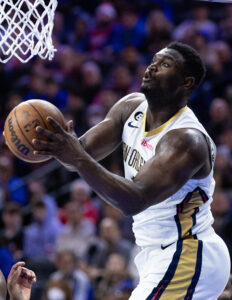According to betting site BetOnline.ag, Bucks center Brook Lopez and Grizzlies forward/center Jaren Jackson Jr. are in a two-man race for the NBA’s Defensive Player of the Year award.
Interestingly, when I considered doing a Community Shootaround on this topic a few weeks ago, Jackson was a pretty strong favorite with Lopez the runner-up, but those odds have flipped — Lopez is currently the leading candidate at minus-225, followed by Jackson at plus-175. The only other two players listed are Bucks big man Giannis Antetokounmpo (plus-2500) and Heat center Bam Adebayo (plus-3300), but they’re considered long shots with the regular season nearing its conclusion.
Both Lopez and Jackson have compelling cases. Lopez anchors the NBA’s top defense, which is the primary reason the Bucks have the best record in the league. With Lopez on the court, the Bucks have a 106.3 defensive rating, and they’re 4.1 points per 100 possessions worse defensively when he’s not playing.
It’s been a remarkable year for the 34-year-old, who is averaging a career-high 2.5 blocks per game (second in the league) and has only missed two games. According to NBA.com‘s data, he has contested more shots than any player in the league by a significant margin, with opponents shooting 4.5% worse than expected on those attempts. Among players who have contested at least five shots per game at the rim, opponents are shooting just 50% against Lopez, which ranks second in the league, per NBA.com.
Jackson has played 15 fewer games than Lopez following offseason foot surgery, and has played fewer minutes in those games (28.1 MPG compared to 30.6 for Lopez). Barring injury, there’s no way for him to make up ground in those areas. He has only contested 13.8 shots per game versus Lopez’s 22.9.
That said, there’s a strong argument to be made that Jackson has been more impactful in the time he has been on the court, even if he’s played nearly 600 fewer minutes to this point. The Grizzlies hold the league’s third-best defense. With Jackson on the court, the Grizzlies have a 105.7 defensive rating, and they’re 5.7 points worse defensively when he’s off the court.
Lopez ranks second in blocks per game because he trails Jackson, who is averaging 3.0 while leading the league in block percentage. He’s also averaging 1.0 steal compared to 0.5 for Lopez, so Jackson easily clears in steals plus blocks (4.0 vs 3.0).
Opponents are shooting 4.7% worse than expected with Jackson as the nearest defender, and they are only shooting 46.4% at the rim against him — that’s the best mark for a full-time player since 2013/14, according to NBA.com.
We want to know what you think. Who should win the Defensive Player of the Year award in 2022/23? Head to the comments to weigh in with your thoughts!


 Nearly eight months later, Brogdon has made good on that promise — in 51 games as a reserve, his 14.9 points per game represent his worst scoring average since the 2017/18 season, and his 25.5 minutes per game are a career low. But the 30-year-old is leading the NBA with a career-high .465 3PT% and the Celtics own the league’s best record (43-17).
Nearly eight months later, Brogdon has made good on that promise — in 51 games as a reserve, his 14.9 points per game represent his worst scoring average since the 2017/18 season, and his 25.5 minutes per game are a career low. But the 30-year-old is leading the NBA with a career-high .465 3PT% and the Celtics own the league’s best record (43-17). Gilgeous-Alexander, 24, is in his fifth season. Markkanen, 25, is in his sixth. Brunson, 26, is in his fifth. That’s not to take anything away from any of the players whatsoever, I just thought it was interesting that they are slightly more experienced than many of the past winners over the past couple decades.
Gilgeous-Alexander, 24, is in his fifth season. Markkanen, 25, is in his sixth. Brunson, 26, is in his fifth. That’s not to take anything away from any of the players whatsoever, I just thought it was interesting that they are slightly more experienced than many of the past winners over the past couple decades.